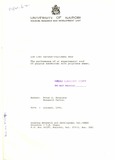| dc.description.abstract | As part of the efforts to arrive at alternative
solutions for roofing at lower cost, an experiment
of a modified papyrus roof was carried out.
Polythene sheets of three different thicknesses
were placed between two layers of papyrus mats.
This experiment was initiated by Mr. J. Eygelaar,
materials engineer of the HRDU, in 1977.
Though in certain rural areas "in Kenya, papyrus
is used as a roofing material, transportation
of big quantities is very costly, which in turn
reduces the amount available for roofing.
Polythene for water tightness was thought to be a
good replacement, due t6 the limited availability
of papyrus. An experimental roof was erected on
a terrace of the building of the Faculty of
Architecture, Design and Development of the University
of Nairobi. (See Photograph 1 below) .
Photograph 1. Overall view of the experimental roof
structure.
The purpose of this experiment was (i) to check the
durability of papyrus against rot, fungi and tear,
(ii) to check the durability of black polythene
sheeting against ultra violet radiation, heat, rot
and (iii) to check the combination of both materials.
This study only deals with the technical aspects
of these materials. Acceptability of this type of
roof in rural areas where papyrus is largely used,
has riot been investigated. Papyrus is also used for
sleeping mats in the rural areas.
-4-
photograph 2. Detailed picture of the method
of sandwiching the polythene and
papyrus mats. View of | en_US |



